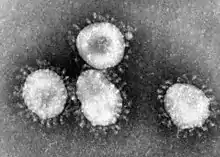Alphacoronavirus
Alphacoronaviruses (Alpha-CoV) are members of the first of the four genera (Alpha-, Beta-, Gamma-, and Delta-) of coronaviruses. They are positive-sense, single-stranded RNA viruses that infect mammals, including humans. They have spherical virions with club-shaped surface projections and a viral envelope.
| Alphacoronavirus | |
|---|---|
 | |
| Porcine epidemic diarrhea virus genome and virion structure | |
| Virus classification | |
| (unranked): | Virus |
| Realm: | Riboviria |
| Kingdom: | Orthornavirae |
| Phylum: | Pisuviricota |
| Class: | Pisoniviricetes |
| Order: | Nidovirales |
| Family: | Coronaviridae |
| Subfamily: | Orthocoronavirinae |
| Genus: | Alphacoronavirus |
| Subgenera and species | |
Alphacoronaviruses are in the subfamily Orthocoronavirinae of the family Coronaviridae. Both the Alpha- and Betacoronavirus lineages descend from the bat viral gene pool.[1][2][3] Alphacoronaviruses were previously known as "phylogroup 1 coronaviruses".
Etymology
The name alphacoronavirus is derived from Ancient Greek ἄλφα (álpha, "the first letter of the Greek alphabet"), and κορώνη (korṓnē, “garland, wreath”), meaning crown, which describes the appearance of the surface projections seen under electron microscopy that resemble a solar corona.[4]
Structure
The virion is enveloped and spherical measuring 120–160 nm in diameter and a core shell of about 65 nm. Glycoproteins and trimers form large surface projections which create the appearance of solar corona. This genus, like other coronaviruses, has a spike protein with a type II fusion machine (S2) and a receptor-binding domain (S1). It assembles into a trimer. Unlike beta- and gammacoronaviruses, this protein is not cleaved into two halves.[5]
Genome

The genome is positive-sense, single-stranded RNA with a length of 27 to 29 kilobases and a 3’-polyA tail. Two large, overlapping ORFs at the 5'-end of the genome encode the major non-structural proteins expressed as a fusion protein by ribosomal frameshift. These include regions with protease, helicase and RNA polymerase motifs. There are seven other genes downstream which encode structural proteins. These are expressed from a 3'-coterminal nested set of subgenomic mRNAs.
Recombination
Both types of Alphacoronavirus 1, feline coronavirus (FCoV) and canine coronavirus (CCoV), are known to exist in two serotypes. Serotype II targets Aminopeptidase N, while the receptor for Serotype I is unknown. The difference is due to a different spike protein.[7] There is a common ancestor for FCoV and CCoV. This ancestor gradually evolved into FCoV I and CCoV I. An S protein from an unknown virus was recombined into the ancestor and gave rise to CCoV II. CCoV II once again recombined with FCoV to create FCoV II. CCoV II gradually evolved into TGEV. A spike deletion in TGEV creates PRCV. All these viruses are sorted into the subgenus Tegacovirus.[7]
Classification

The following subgenera and species are recognized:[8]
| Coronavirus |
|---|
 |
See also
References
- Woo, P. C.; Wang, M.; Lau, S. K.; Xu, H.; Poon, R. W.; Guo, R.; Wong, B. H.; Gao, K.; Tsoi, H. W.; Huang, Y.; Li, K. S.; Lam, C. S.; Chan, K. H.; Zheng, B. J.; Yuen, K. Y. (2007). "Comparative analysis of twelve genomes of three novel group 2c and group 2d coronaviruses reveals unique group and subgroup features". Journal of Virology. 81 (4): 1574–85. doi:10.1128/JVI.02182-06. PMC 1797546. PMID 17121802.
- Lau, S. K.; Woo, P. C.; Yip, C. C.; Fan, R. Y.; Huang, Y.; Wang, M.; Guo, R.; Lam, C. S.; Tsang, A. K.; Lai, K. K.; Chan, K. H.; Che, X. Y.; Zheng, B. J.; Yuen, K. Y. (2012). "Isolation and characterization of a novel Betacoronavirus subgroup A coronavirus, rabbit coronavirus HKU14, from domestic rabbits". Journal of Virology. 86 (10): 5481–96. doi:10.1128/JVI.06927-11. PMC 3347282. PMID 22398294.
- Lau, S. K.; Poon, R. W.; Wong, B. H.; Wang, M.; Huang, Y.; Xu, H.; Guo, R.; Li, K. S.; Gao, K.; Chan, K. H.; Zheng, B. J.; Woo, P. C.; Yuen, K. Y. (2010). "Coexistence of different genotypes in the same bat and serological characterization of Rousettus bat coronavirus HKU9 belonging to a novel Betacoronavirus subgroup". Journal of Virology. 84 (21): 11385–94. doi:10.1128/JVI.01121-10. PMC 2953156. PMID 20702646.
- Decaro, Nicola (2011). "Alphacoronavirus". The Springer Index of Viruses. pp. 371–383. doi:10.1007/978-0-387-95919-1_56. ISBN 978-0-387-95918-4.
- Wrapp, Daniel; McLellan, Jason S.; Gallagher, Tom (13 November 2019). "The 3.1-Angstrom Cryo-electron Microscopy Structure of the Porcine Epidemic Diarrhea Virus Spike Protein in the Prefusion Conformation". Journal of Virology. 93 (23): e00923-19. doi:10.1128/JVI.00923-19. PMC 6854500. PMID 31534041.
- Le Poder, Sophie (2011-07-31). "Feline and Canine Coronaviruses: Common Genetic and Pathobiological Features". Advances in Virology. Retrieved 2020-06-29.
- Jaimes, Javier A.; Millet, Jean K.; Stout, Alison E.; André, Nicole M.; Whittaker, Gary R. (10 January 2020). "A Tale of Two Viruses: The Distinct Spike Glycoproteins of Feline Coronaviruses". Viruses. 12 (1): 83. doi:10.3390/v12010083. PMC 7019228. PMID 31936749.
- "Virus Taxonomy: 2019 Release". talk.ictvonline.org. International Committee on Taxonomy of Viruses. Retrieved 20 June 2020.